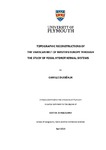Topographic reconstructions of the Variscan Belt of Western Europe through the study of fossil hydrothermal systems
| dc.contributor.supervisor | Gébelin, Aude | |
| dc.contributor.author | Dusséaux, Camille | |
| dc.contributor.other | School of Geography, Earth and Environmental Sciences | en_US |
| dc.date.accessioned | 2019-09-11T09:04:15Z | |
| dc.date.issued | 2019 | |
| dc.date.issued | 2019 | |
| dc.identifier | 10541191 | en_US |
| dc.identifier.uri | http://hdl.handle.net/10026.1/14908 | |
| dc.description | Section III-A is based upon a paper published in the journal Terra Nova in August 2019: Dusséaux C., Gébelin A., Boulvais P., Gardien V., Grimes S., Mulch A. (2019) Meteoric fluid-rock interaction in Variscan shear zones. Terra Nova, vol. 31, issue 4, p. 366-372. DOI: 10.1111/ter.12392. | en_US |
| dc.description.abstract |
This thesis presents the first stable isotope quantification of paleoaltimetry for the Variscan Belt of Western Europe that integrates late-Carboniferous hydrogen isotope ratios of meteoric water in the internal zones in the Armorican Massif (AM) and the French Massif Central (FMC) with age-equivalent precipitation records in the foreland Bourbon l’Archambault basin (BA) and the Montagne Noire (MN). Combined microstructural, hydrogen and oxygen stable isotope, thermometry and geochronology data allow the calculation of the isotopic composition of meteoric water in the internal zones of the orogen where surface-derived fluids infiltrated the ductile segment of the Quiberon, Piriac (AM) and Felletin (FMC) detachment shear zones during high temperature deformation and post-orogenic extension. When compared to age-equivalent isotopic composition of surface-derived fluids based on freshwater shark remains found in the BA basin near sea level, the composition of meteoric water obtained from synkinematic muscovite in the detachment footwalls are consistent with a minimum elevation difference of 2500 ± 900 m in the AM and 3300 ± 1000 m for the FMC. This study suggests that the internal zones (AM and FMC) of the Variscan Belt of Western Europe were characterized by a mean elevation typical for medium-sized mountain belts. These results are in good agreement with the view of the Variscan belt as a hot orogen characterized by abundant syntectonic crustal melting and high-grade metamorphism that profoundly affected its tectonic evolution. | en_US |
| dc.language.iso | en | |
| dc.publisher | University of Plymouth | |
| dc.rights | Attribution-NonCommercial-NoDerivs 3.0 United States | * |
| dc.rights.uri | http://creativecommons.org/licenses/by-nc-nd/3.0/us/ | * |
| dc.subject | Variscan | en_US |
| dc.subject | Tectonics | en_US |
| dc.subject | Geochemistry | en_US |
| dc.subject | Structural geology | en_US |
| dc.subject | Hydrous minerals | en_US |
| dc.subject | Hydrogen isotope | en_US |
| dc.subject | Meteoric water | en_US |
| dc.subject | Paleoelevation | en_US |
| dc.subject | Stable isotope paleoaltimetry | en_US |
| dc.subject.classification | PhD | en_US |
| dc.title | Topographic reconstructions of the Variscan Belt of Western Europe through the study of fossil hydrothermal systems | en_US |
| dc.type | Thesis | |
| plymouth.version | publishable | en_US |
| dc.identifier.doi | http://dx.doi.org/10.24382/576 | |
| dc.rights.embargodate | 2020-09-11T09:04:15Z | |
| dc.rights.embargoperiod | 12 months | en_US |
| dc.type.qualification | Doctorate | en_US |
| rioxxterms.version | NA | |
| plymouth.orcid.id | https://orcid.org/0000-0002-4716-5414 | en_US |
Files in this item
This item appears in the following Collection(s)
-
01 Research Theses Main Collection
Research Theses Main



